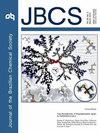基于靶邻近诱导铜纳米簇荧光猝灭的BRCA1基因敏感检测
IF 1.3
4区 化学
Q3 CHEMISTRY, MULTIDISCIPLINARY
引用次数: 0
摘要
乳腺癌易感基因1 (BRCA1)突变在遗传性乳腺癌中起重要作用。因此,BRCA1基因的灵敏检测对于疾病诊断和人类健康具有极其重要的意义。本文建立了一种基于荧光铜纳米团簇(CuNCs)的快速、灵敏和选择性检测技术。以聚(AT-TA)双链DNA (dsDNA)为模板,成功构建了cccs。在没有目标物的情况下,在365 nm紫外灯下观察到强烈的红色发射,并获得了较大的荧光响应。然而,当BRCA1基因存在时,由于靶标邻近诱导的cucs荧光猝灭,只产生微弱的红色发射,产生低响应信号。BRCA1基因检测的线性范围为2 ~ 600 nM,检测限为2 nM。该方法对稀释后的血清样品中BRCA1基因的检测具有良好的选择性、稳定性和回收率。此外,通过集成紫外线灯和智能手机,荧光传感器将转移到微流控芯片上,为即时监测乳腺癌风险提供了一个有前景的应用。本文章由计算机程序翻译,如有差异,请以英文原文为准。
Sensitive Detection of BRCA1 Gene Based on Target Proximity Induced Quenching of the Fluorescence of Copper Nanoclusters
The mutations of breast cancer susceptibility gene 1 (BRCA1) play an important role in inherited breast cancers. Thus, the sensitive assay of the BRCA1 gene is extremely important for disease diagnosis and human health. Herein, a fast, sensitive and selective assay technique has been constructed based on fluorescent copper nanoclusters (CuNCs). The CuNCs were successfully formed with poly(AT-TA) double stranded DNA (dsDNA) as template. In the absence of the target, a strong red emission was observed under 365 nm ultraviolet (UV) lamp and a big fluorescence response was obtained. However, in the presence of BRCA1 gene, there was only weak red emission and a low response signal was produced because of the target-proximity induced quenching of the fluorescence of CuNCs. The linear range for the BRCA1 gene assay was 2-600 nM, and the limit of detection was 2 nM. The assay technique showed good selectivity, good stability and satisfactory recoveries for the detection of BRCA1 gene in diluted serum samples. Moreover, by integrating a UV lamp and a smartphone, the fluorescence sensor would be transferred to a microfluidic chip, providing a prospective application in point-of-care for monitoring breast cancer risk.
求助全文
通过发布文献求助,成功后即可免费获取论文全文。
去求助
来源期刊
CiteScore
2.90
自引率
7.10%
发文量
99
审稿时长
3.4 months
期刊介绍:
The Journal of the Brazilian Chemical Society embraces all aspects of chemistry except education, philosophy and history of chemistry. It is a medium for reporting selected original and significant contributions to new chemical knowledge.

 求助内容:
求助内容: 应助结果提醒方式:
应助结果提醒方式:


